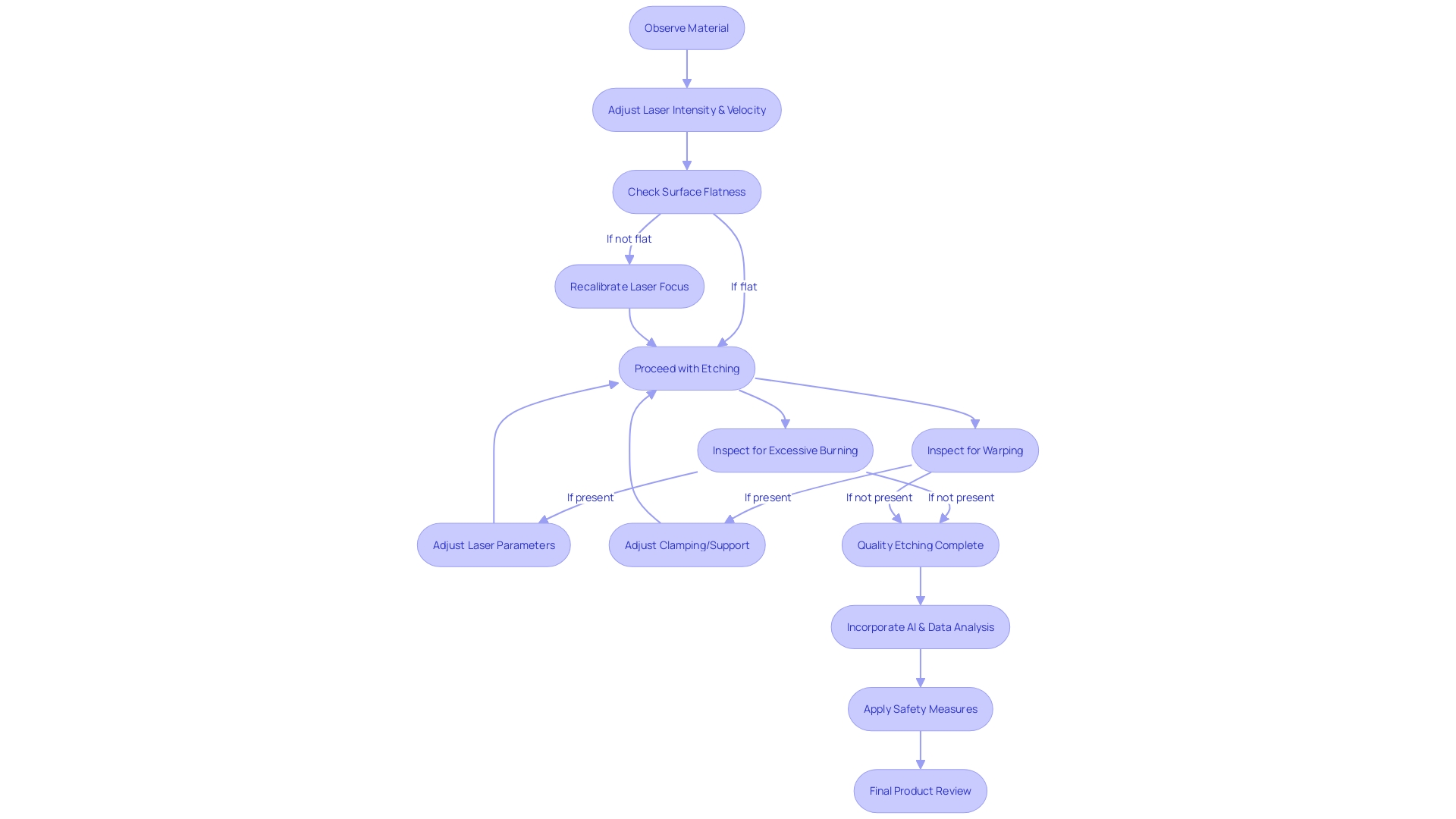Introduction
Plastic engraving is a versatile and creative process that allows for the customization and branding of various items. However, choosing the right plastic and laser engraver is crucial to achieve high-quality results and ensure safety. In this article, we will explore the different types of plastics suitable for laser engraving, the optimal settings for engraving each type, the step-by-step process of laser engraving plastics, common issues and troubleshooting tips, safety measures and preparation, and alternative methods for engraving plastics.
So, whether you're a beginner or an experienced engraver, this guide will provide you with valuable insights and techniques to enhance your plastic engraving projects.
Types of Plastics Suitable for Laser Engraving
Selecting the correct material for etching with a laser is vital to prevent toxic fumes and achieve top-notch outcomes. Here's a rundown of plastics that are not only safe but also yield excellent engravings:
- Acrylic, often referred to as Plexiglas, is a go-to for its clear, glass-like appearance and robustness, making it perfect for both aesthetic and functional pieces.
- ABS, a popular choice in the 3D printing world, withstands the high level of intensity emitted by the beam.
- Polycarbonate is lauded for its toughness and is a staple in industrial settings where durability is key. Delrin, an engineering plastic, is highly valued for its stability and ability to produce intricate designs.
- Polypropylene brings versatility to the table, accommodating a wide array of engraving applications.
Before diving into your project, remember safety first! Gear up with protective eyewear and ensure your workspace is well-ventilated. For those crafting intricate designs or serial numbers, the accuracy of a beam of light is unmatched. And if you're venturing into making your own acrylic keyboard case or similar, a CO2 cutter with at least 40 watts of power is your best bet for cutting through 3mm thick acrylic with ease.
Engraving depth isn't typically an issue as the process is more about surface modification. However, if cutting is on the agenda, the thickness of your material becomes a critical factor. Always work in a safe environment, as light beams require enclosures for secure operation, especially if there are children or pets around.
As light amplification by stimulated emission of radiation technology continues to evolve, it's exciting to witness the emergence of new theories and materials that promise to revolutionize the industry, enhancing the capabilities of light amplification by stimulated emission of radiation devices. It's a field that's always pushing the boundaries, striving for miniaturization, integration, and functionality.
Choosing the Right Laser for Plastic Engraving
Exploring the realm of engraving, particularly in relation to plastics, demands an informed approach. Here's a distilled guide to help you choose the right laser engraver for your specific needs:
-
Laser Power: It's all about the energy! The power rating of your light beam affects how deep and fast you can engrave. If you're working with thicker materials, aim for a device with more power.
-
Wavelength Compatibility: Plastics have their own personalities when interacting with light beams. Ensure that the beam's wavelength is suitable for the kind of plastic you are working with to prevent any material accidents.
-
Workspace Dimensions: Size does matter here. The engraving area of your device should be spacious enough for the items you're looking to brand or beautify.
-
Software Synergy: Your software solution is your creative ally. Make sure that the engraver you're interested in works well with your preferred design and control software.
-
Budget Considerations: Set your financial boundaries and explore within them. Don't forget to account for ongoing costs like maintenance and supplies.
Bear in mind, etching using focused light is not only about technology but also about safety and creativity. Protective gear is necessary, and a well-ventilated workspace ensures your carving endeavor is not only successful but also safe (Jacques from modular company.com). Whether you're cutting intricate designs for a custom keyboard case with a CO2 laser or etching delicate patterns, the right machine makes all the difference. No minimum orders, no barriers to entry—just pure creation.

Optimal Settings for Engraving Different Plastics
- Acrylic can be a delight for engravers when the correct settings are dialed in. Strive for reduced power combined with increased velocities to prevent melting, and you'll be compensated with markings that are sharp and shiny.
- With ABS, it's a delicate dance to find that sweet spot where the depth of the etching and the surface finish are in harmony. Tinker with the settings to find your perfect match. Polycarbonate requires some patience and a firm grip; reducing the speed and increasing the force create carvings with depth and precision.
- Delrin's gentle texture necessitates a cautious technique - reduced force and rapid motions avert melting and offer you with etchings that are distinct and accurate.
- Polypropylene might challenge your patience, but through a series of experiments to discover the perfect power and speed, you'll achieve markings that are profound without the inconvenience of melting or warping.

Step-by-Step Guide to Laser Engraving Plastics
'Using laser technology on polymers is not only concerned with appearance; it is a crucial procedure employed by companies to guarantee the traceability and genuineness of their goods.'. As Veronica Savu, CEO of Morphotonix, emphasizes, the intricacies of supply-chain dynamics and the rise in counterfeit goods necessitate such measures to protect consumer safety and brand integrity. The technique of engraving with a focused beam can be divided into straightforward steps, starting with a clean plastic surface to ensure a sharp result. Alignment of the engraver is crucial; as it must be precisely calibrated for accuracy. The design phase is where creativity meets technology, employing software that ranges from simple drawing programs to sophisticated CAD systems, depending on your expertise. Modifying the settings is crucial, considering the plastic's characteristics to prevent defects that can occur from improper temperature and pressure control. A test run on a sample ensures that your settings yield the desired effect. When etching, supervising the process is crucial for a seamless execution, and after etching, the product should be washed and examined for flaws. Final touches may include painting or polishing, depending on the end goal. With advancements in technology, precision in etching using lasers is now accomplished with tools like a four-axis all-metal robotic arm, ensuring that even the most intricate designs are flawlessly rendered. The potential of utilizing laser technology to create detailed designs and markings in the manufacturing industry is vast and ever-growing, as reported in the latest research from the Optica Publishing Group, making it an indispensable tool in today's market.
Common Issues and Troubleshooting Tips
Mastering the challenges of etching synthetic materials can be a meticulous task, but with the right approach, you can enhance the quality and precision of your etchings. To begin with, if you observe the synthetic material melting, decrease the laser's intensity while increasing the velocity of the etching process. This equilibrium reduces heat focal point and maintains the integrity of the material.
When dealing with inconsistent engraving depths, the culprit is often an uneven surface. Make sure your material is perfectly flat and securely fixed to avoid any variations. If the engraved image appears blurry or lacks clarity, it's crucial to recalibrate the laser's focus. A clean lens is vital for crisp results, so regular maintenance should not be overlooked.
Excessive burning is a sign of overly high power settings. Adjusting both the strength and velocity is crucial to avoid harm to the material. Furthermore, warping can happen because of the heat produced while etching. Using reduced power settings in combination with higher speeds for etching can assist in preserving the shape of the plastic.
As we explore further into the complex world of etching, it's evident that accuracy is of utmost importance. Incorporating cutting-edge technologies, such as the four-axis all-metal robotic arm controlled by advanced path planning software, can enhance your projects from basic patterns to intricate, multidimensional designs. This technological evolution is not only revolutionizing the production floor but also plays a crucial role in combating the rise of counterfeit products in increasingly complex supply chains. By utilizing etching technology for traceability and authentication, manufacturers can safeguard their brand integrity and ensure consumer safety.
Remember to prioritize safety by donning protective eyewear and operating in a well-ventilated space with a fire extinguisher at hand. Following these best practices and advancements in the art of etching will not only help to overcome common issues but also open up possibilities for creating durable, high-quality engraved plastics that stand the test of time.

Safety Measures and Preparation
When it comes to etching with lasers, precision and safety are paramount. With advanced technology being an integral part of various industries, from creating detailed medical devices to ensuring product authenticity, taking the right precautions is essential. To begin your journey of laser marking, safeguard your eyes with specialized eyewear suitable for the specific wavelength of your laser. A well-ventilated workspace is also crucial to disperse any fumes or smoke that might be produced during the etching process; a fume extraction system can be a valuable addition here.
Fire safety should never be overlooked. Given the potential flammability of materials, it is crucial to have a fire extinguisher nearby and to never leave the device unattended. Before you start, confirm that the plastic you intend to mark is suitable for laser etching to avoid releasing any toxic fumes. Lastly, make sure that anyone operating the engraving device is properly trained and familiar with all safety features and emergency protocols.
Implementing these safety precautions not only protects your health but also guarantees the authenticity of your work, enabling you to create accurate and top-notch designs. From encoding RFID tags for security purposes to creating intricate medical devices, laser marking is a powerful tool that, when used responsibly, can yield exceptional results.
Alternative Methods for Engraving Plastics
Exploring different methods of engraving materials can reveal a universe of possibilities for aesthetics and usability. CNC Routing offers meticulous precision through its computer-controlled cutting tool, carving out intricate details with ease. Sandblasting, in contrast, uses high-pressure air along with abrasive materials to create distinctive patterns that lead to a textured surface. For those seeking depth and meticulous cuts, Mechanical Engraving stands out as it uses a sharp rotating tool to carve designs into plastic surfaces. Chemical Etching, a technique that utilizes selective chemicals to eliminate material, provides a unique method for producing enduring marks.
In a time where product authenticity is paramount, Veronica Savu, CEO of Morphotonix, emphasizes the need for traceability and authentication features that can be integrated into molded products. This is especially critical in combating the rise of counterfeit components which can compromise consumer safety and industry integrity. Advanced techniques like laser etching are becoming crucial in preserving product authenticity.
For creative applications, 3D printing offers a fresh approach to creating engraved patterns. As observed in a Hackaday article, 3D printed molds have been effectively utilized for concrete signage, showcasing the adaptability of marking methods. These advances in technology are reshaping the way we approach design and production, offering innovative solutions that address both aesthetic and security concerns.
Considering the importance of etching in product distinction and safeguarding, the innovative solutions by companies like Morphotonix play a vital role. They not only affirm the authenticity of products in industries such as medical, automotive, and packaging but also safeguard the brand's reputation and intellectual property.
Lastly, adopting new techniques in etching aligns with the progressive values of companies like Sandvik Coromant, who consistently pursue sustainable, efficient, and growth-focused solutions. As the industry evolves, so does the need for cutting-edge techniques that enhance quality, reduce costs, and improve overall throughput. These alternative plastic engraving methods provide a myriad of options for brands looking to distinguish themselves and ensure the validity of their products.
Conclusion
In conclusion, plastic engraving is a versatile process that requires choosing the right plastic and laser engraver to achieve high-quality results and ensure safety. Acrylic, ABS, polycarbonate, Delrin, and polypropylene are suitable plastics for laser engraving, each with its own optimal settings. When choosing a laser engraver, consider factors like laser power, wavelength compatibility, workspace dimensions, software synergy, and budget.
The right machine can make a significant difference in the outcome of your engravings. To achieve the best results, adjust the power and speed settings based on the type of plastic being engraved. Safety measures, such as wearing protective eyewear and working in a well-ventilated space, should always be followed.
The step-by-step process of laser engraving involves preparing the plastic surface, calibrating the laser, designing with appropriate software, adjusting settings, conducting a test run, monitoring the process, and adding final touches. Advancements in technology, like robotic arms, have made precision engraving more accessible. Common issues in laser engraving plastics can be addressed by adjusting power and speed, ensuring a flat surface, recalibrating the laser's focus, and maintaining a clean lens.
Safety measures, such as proper eye protection and fire safety, are essential. Alternative methods like CNC routing, sandblasting, mechanical engraving, and chemical etching offer different options for design and functionality. They play a crucial role in maintaining product authenticity and protecting consumer safety.
In summary, by understanding the suitable plastics, choosing the right laser engraver, adjusting optimal settings, following a step-by-step process, troubleshooting common issues, and prioritizing safety, you can enhance your plastic engraving projects and achieve exceptional results.




